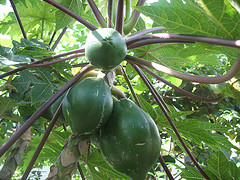Papayas
| Infobox on Papayas | |
|---|---|
| Example of Papayas |  |
| Freshness facts | |
| Optimum carrying temperature | 10°C (green) 7°C (turning) |
| Highest freezing point | -0,9°C |
| Acceptable product temp. at loading into containers | Max. 2°C above carrying temperature |
| Optimum humidity | 90% |
| Ventilation setting for containers | 25 m³/hr |
| Storage life | 3-4 weeks (green) 2-3 weeks (turning) |
| Climacteric / non-climacteric | Climacteric |
| Ethylene production | High |
| Ethylene sensitivity | High |
| Modified / controlled atmosphere | 5%-8% CO2; 2%-5% O2 |
| Potential benefits | Slight to moderate |
| Availability | |
| South Africa South America Central America |
November - May November-June |
Papayas
Contents
Harvesting and handling
Papayas are very sensitive sub-tropical fruit, which bruise easily and ripen very fast when exposed to high temperatures. Papayas are climacteric fruits and, for long-distance transport, must be harvested mature green. Judging the correct stage is difficult, and in any batch of harvested fruit there will be a varying range of maturity, some fruits perhaps incapable of normal ripening. Care is necessary during harvesting, to minimise injury and to prevent latex (which oozes out of the cut stem-end) from disfiguring the fruit.
Papayas must be handled very carefully and should be kept dry during all phases of handling and transport. Size, shape, smooth skin, and absence of blemishes are major quality characteristics.
Cooling and storage
For maximum extension of storage life it is advantageous to remove ethylene produced by the fruit itself. The optimal storage temperature is generally given as +7°C for ripe/turning and +10°C for green fruits, if chilling is to be avoided. At these temperatures, green papayas have a PSL (Potential Storage Life) of 3-4 weeks, and turning papayas 2-3 weeks.
The critical temperature, below which chilling injury may occur, is generally considered to be about 7°C for ripe fruits and 10°C for green fruits. Papaya fruit become progressively less susceptible to chilling stress as they ripen. Injury may not be apparent until the fruit is returned to a higher temperature. External signs are small spots, which are dark olive on green fruit and light brown on yellow fruits. They may coalesce to form scald-like areas on the skin. Mild bruises appear more pronounced, and ripening fruits develop a blotchy appearance. Other characteristics include breakdown of the pulp and increased susceptibility to decay, especially Alternaria rot.
Mixed loads
Do not ship with ethylene-producing commodities or ethylene-sensitive commodities.
Cautions
O2 below 2% for longer than two weeks can cause off-flavours and failure to ripen. CO2 above 10% can cause off-flavours and may aggravate chilling injury.
Storage disorders
Alternaria rot, Anthracnose, Black rot, Black spot, Blue mould, Chilling injury, Cladosporium rot, Fusarium, Phytophtora, Rhizopus rot, Stem end rot.











